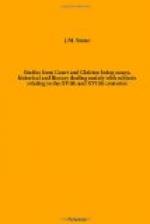Nevertheless, that the influence of Foxe is not by any means extinct in our own day, is proved by the successive republications of his book during the nineteenth century. In 1836 the plea for a new edition was put forward in a letter to the editor of the Record in these astounding terms:—
“When we consider the high character of the work for accuracy of detail; its full exhibition of the Gospel in all its holy and triumphant efficacy; the bulwark it has proved to our Protestant faith; its peculiar seasonableness to meet all the fresh dangers from Popery in the present times; and its intrinsic value, as forming a sound standard of Reformation divinity, we find it an exercise of Christian charity to call the public attention to it. We might further adduce the imprimatur of our own Church, by her act of Convocation appending it to all the ecclesiastical establishments in the land, as giving to Foxe’s work, an additional claim of regard.”
Between the years 1836-41, therefore, a new edition was published by the Rev. S. R. Cattley, with a Life and Vindication of John Foxe, by Prebendary Townsend of Durham.
The Rev. Josiah Pratt reprinted it in 1846-49; another edition, purporting to be corrected by the Rev. Josiah Pratt, the younger, appearing in 1853. But the Life and Vindication had been so greatly discredited in the attack made upon it by Dr. S. R. Maitland, that when the Religious Tract Society published an edition of the Acts and Monuments in 1877, mainly from the stereotype plates of that of 1853, they thought it prudent to omit that part altogether, Dr. Stoughton, one of the honorary secretaries of the Society, substituting an Introduction, a work which is, however, as much open to criticism as Townsend’s.




